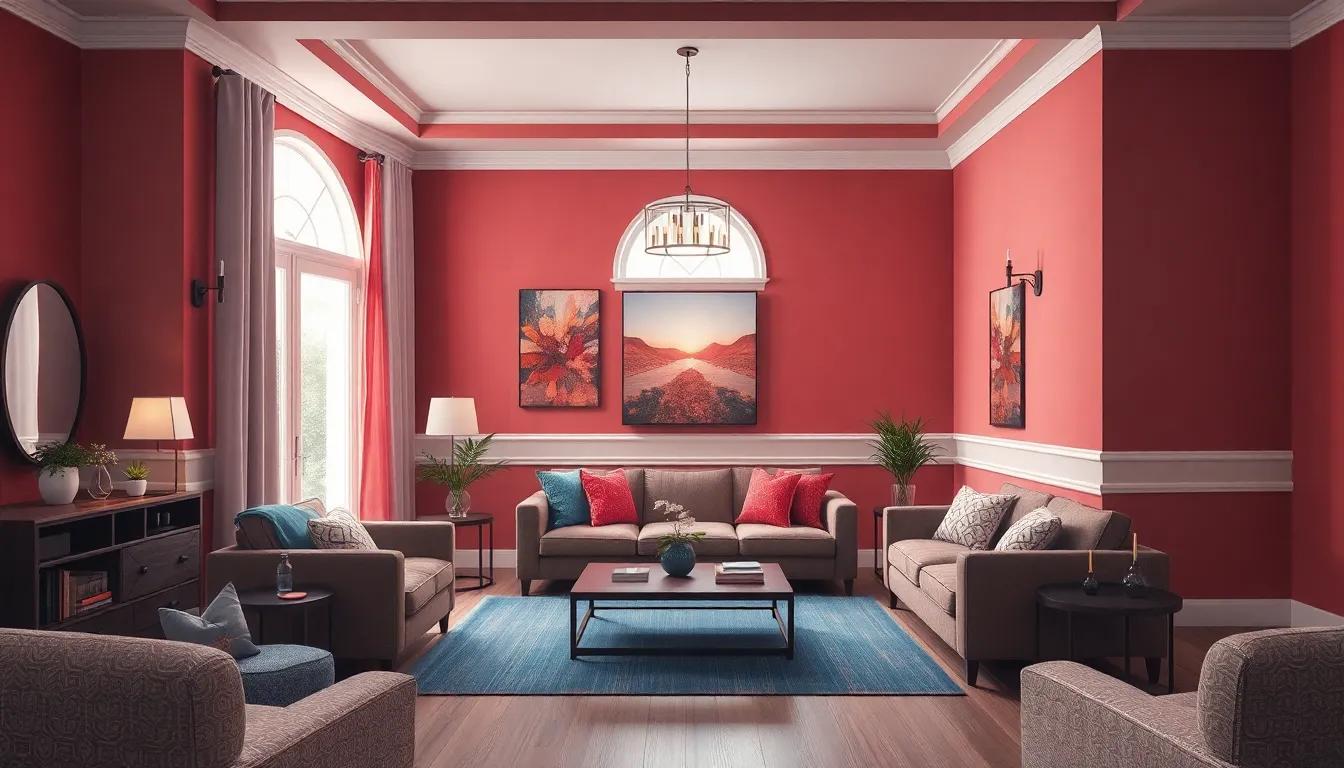Decor design isn’t just about throwing a few cushions on a couch and calling it a day. It’s an art form that transforms spaces from drab to fab faster than you can say “throw pillow.” Whether it’s a cozy nook or a sprawling living room, the right decor can make all the difference, turning a house into a home and a yawn into a “wow!”
Table of Contents
ToggleOverview of Decor Design
Decor design embodies a complex art form, integrating aesthetics and functionality within spaces. Incorporating elements like color, texture, and furniture creates a cohesive atmosphere that reflects personal style. Practitioners focus on maximizing space utility while enhancing visual appeal.
Room layouts play a crucial role in decor design. Strategically placing furniture can improve flow and make areas feel more open. Combining various design principles, such as balance and harmony, leads to a well-rounded environment.
Materials significantly impact decor choices. Sustainable options, like bamboo and recycled wood, are increasingly popular due to their environmental benefits. Textiles, ranging from cotton to velvet, also contribute to a room’s warmth and texture.
Color selection shapes emotional responses within spaces. Warm hues like red and orange create energy, while cool tones like blue and green promote tranquility. Lighting influences these effects, as natural light often enhances color vibrancy, creating a lively atmosphere.
Incorporating art and accessories adds character to spaces. Pieces such as wall art, sculptures, and plants bring visual interest while reflecting the inhabitants’ tastes. Functionality should connect seamlessly with aesthetic elements, maintaining practicality alongside beauty.
Technological advancements bring innovative decor solutions. Smart home devices can blend with design while offering conveniences like automated lighting and climate control. These integrations enhance cozy living environments, reinforcing the space’s overall appeal.
Overall, decor design fosters an inviting atmosphere that adapts to personal needs and preferences. Cultivating an environment that resonates with its occupants remains the ultimate goal of successful decor.
Key Elements of Decor Design

Decor design encompasses several key elements that significantly impact the appearance and feel of a space.
Color Schemes
Selecting a color scheme sets the mood and influences how occupants feel in a room. Warm colors like reds and oranges create energy, while cool colors such as blues and greens evoke tranquility. Harmonious palettes enhance cohesion throughout a home, ensuring that each space flows into the next seamlessly. Accent colors provide visual interest and can draw attention to specific features, like artwork or furniture pieces. Utilizing neutral tones serves as a backdrop to help bolder accents stand out, capturing the overall essence of the designed atmosphere.
Furniture Selection
Choosing furniture involves balancing aesthetics with functionality. Each piece contributes to the overall design, so it’s crucial to select furniture that complements the color scheme and style of the decor. Consideration of scale ensures that oversized sections don’t overwhelm a space, while smaller items can create a cozy atmosphere. Multi-functional furniture offers practical solutions, especially in smaller rooms. Quality craftsmanship and materials enhance durability and appeal, ultimately tying the entire decor together.
Lighting Choices
Lighting plays a pivotal role in enhancing decor design by establishing ambiance. Natural light maximizes openness, creating an inviting environment during the day. Layering different lighting types, such as ambient, task, and accent lighting, allows for versatility in mood and function. Pendant lights can serve as focal points, while softer wall sconces maintain a warm atmosphere. Smart lighting options provide control over brightness and color, adapting to various occasions and preferences effortlessly.
Popular Decor Design Styles
Decor design embraces numerous styles, reflecting diverse tastes and preferences. Each style offers unique characteristics that can transform spaces.
Modern Decor Design
Modern decor design emphasizes simplicity and functionality. Clean lines and minimalistic elements define this style. Typically, it features neutral color palettes complemented by bold accent colors. Open spaces enhance the overall flow, creating an uncluttered appearance. Materials like glass and metal are common, adding a sleek touch. Furnishings focus on practicality and comfort, often showcasing innovative designs. Lighting plays a vital role, with fixtures that blend form and function seamlessly.
Rustic Decor Design
Rustic decor design brings the charm of nature indoors. Warm, earthy tones and raw materials create a cozy, inviting atmosphere. Wood elements such as reclaimed beams and distressed finishes highlight craftsmanship. Accessories often include handmade items that emphasize authenticity. Fabrics like burlap and cotton contribute to warmth and texture throughout the space. Natural light enhances the rustic ambiance, making rooms feel bright and airy. This style embraces imperfections, celebrating the beauty of natural aging.
Bohemian Decor Design
Bohemian decor design reflects a laid-back, eclectic lifestyle. Rich colors and varied patterns come together to create vibrant, visually interesting spaces. The use of textiles is abundant, with rugs, tapestries, and cushions inviting comfort. Plants play a significant role, adding life and freshness to the overall aesthetic. Curated collections of art and global accessories contribute to the unique character of each space. Layering different styles fosters a sense of personalization. This style encourages creativity and expression, creating a dynamic environment that’s both relaxed and inspiring.
Tips for Effective Decor Design
Choosing the right color palette serves as a foundation for decor design. Warm tones create an energizing environment, while cool shades induce calmness. Incorporating a harmonious color scheme enhances a home’s coherence.
Focusing on lighting transforms the perception of any space. Natural light expands areas, making them feel larger, while layered lighting options allow for mood adjustments. This aspect significantly impacts how colors and textures are perceived.
Selecting versatile furniture promotes functionality. Multi-functional pieces save space and cater to various needs. Quality craftsmanship not only improves aesthetics but ensures durability, enhancing overall decor.
Arranging furniture strategically improves flow and openness. It’s vital to consider scale when placing items, ensuring they complement one another in size. Well-planned layouts foster a sense of harmony and ease of movement.
Incorporating unique art and accessories adds a personal touch to decor. Thoughtfully chosen pieces reflect individual style and contribute character to spaces. Balancing these elements with functionality ensures a cohesive approach.
Utilizing sustainable materials plays a key role in modern decor design. Options like reclaimed wood and organic textiles not only enhance aesthetics but also promote environmental responsibility. This choice resonates with a growing trend towards eco-friendly practices.
Integrating technology enhances convenience without sacrificing design. Smart home devices can provide seamless control over lighting and ambiance. This innovative aspect supports contemporary lifestyles effortlessly.
Embracing various decor styles allows for personalization. Each unique style, from modern minimalism to rustic charm, offers different attributes to enhance spaces. Understanding these nuances helps individuals express their tastes effectively.
Decor design is an essential aspect of creating inviting and functional spaces. It blends aesthetics with practicality to reflect personal style while enhancing the overall ambiance of a home. By thoughtfully selecting colors, textures, and furniture, individuals can transform their environments into harmonious retreats.
The integration of technology and sustainable materials further elevates decor design, making it more accessible and eco-friendly. Each decor style offers unique opportunities for expression, allowing homeowners to curate spaces that resonate with their personalities. Ultimately, successful decor design not only beautifies a home but also fosters comfort and connection for those who inhabit it.




